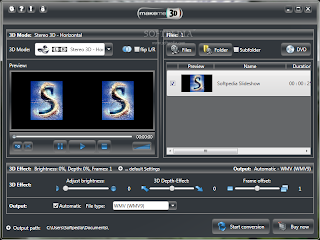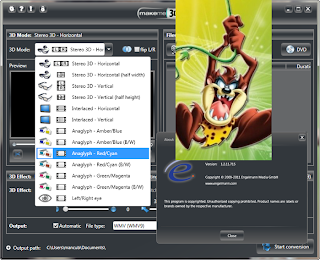In the movies nothings works anymore without 3D now the technique enters the home cinema and even the PC. Engelmann Software presents the world premiere Windows-Software MakeMe3D, which will be released soon. This software can convert existing 2D-videos automatically into the third dimension. The new 3D-videos are compatible to the known Anaglyph 3D glasses and to the new Stereoscopic 3D Hardware.
3D is currently 'the one' new technique. What was hardly conceivable a few months ago has become reality long since. The audience in the cinema put on the 3D-glasses to watch movies in a completely new dimension. And a lot more is happening: the industry is busy tinkering with the 3D-Blu-ray Disc, the 3D-TV and the 3D-computer. This undoubtedly marks only the beginning of a new 3D-boom, which will keep entertainment electronics and IT-sector busy for the next ten years.
MakeMe3D is extremely easy to operate: new technology does not necessarily have to be complicated. The program supports the import of 2D-videos and others in formats Video-DVD, AVI, WMV, MP4, 3GP, MPG and TS, to mention only the most important. The program stores the converted 3D-videos in formats AVI, MPG, MP4 and WMV. It is possible to select from numerous target profiles. For example, the video resolution is automatically adjusted to the parameters for iPad, PlayStation PS3 or Xbox 360. When converting a large number of 2D-videos the batch mode is an option. This mode converts all videos of a list and saves user precious time.
For 3D-conversion we use our self-developed object recognition and motion analysis. We can force vertical or horizontal output, realize page- or frame flipping, have the brightness adjusted automatically and set the depth effect completely variably.
Overview on 3D techniques
Stereoscopic vision (3D) always depends on whether two separate images with different three-dimensionality reach the brain simultaneously - one per eye. If this is the case, the brain calculates the spatial dimension and distance of all things around us and synchronizes in a permanent process the image information of right and left eye.
Stereoscopy uses this simple computation of two slightly different (because perceived from different perspectives) images. Each eye of the viewer is provided with separate image information, so that a pair of 2D images can create an image of three-dimensionality and the illusion of depth. For this purpose different, competing methods are applied, which use different techniques that provide advantages as well as disadvantages when compared to the respective competitor. Common denominator of nearly all techniques described in the following is that they require suitable glasses in order to perceive three-dimensionality.
Polarization technique
Polarization is based on two differently orientated images, one horizontal and the other one vertical. To present a stereoscopic motion picture, two images are projected superimposed onto the same screen through different polarizing filters. The viewer wears glasses which also contain a pair of polarizing filters so that each eye sees a different image. Disadvantage: you must not bow your head.
When using this technique for television broadcasts, the pixel lines of the TV screen display alternately the horizontal and the vertical image. As a result, only half of the original screen size and quality is available. Since every pixel line is used alternately for each of the two images, each eye only sees 50% of the resolution.
For playback at home the polarization technique requires polarization glasses as well as a compatible 3D screen and a 3D-capable player (like e.g. 3D Blu-ray player).
Shutter technique
The Shutter technique provides the image information alternately for the right and left eye, with 120 frames per second (i.e. 60 per second per eye) to avoid screen flicker.
Compellingly required for using this technique at home is a monitor or a TV-player with at least 120 Hz and so-called shutter glasses. These glasses are controlled by an infrared transmitter and are darkened alternately over one eye in synchronization with the refresh rate of the screen. In contrast to other glasses the shutter glasses require power supply via battery or cable.
In an anaglyph or color filter technique, two colored images are superimposed and the complementary colors are filtered out by means of color films. For viewing you require glasses that are coated with a different color film on each lens. Usual combinations are yellow/blue, red/cyan and green/magenta, the latter being the most commonly used at present. The anaglyph technique is the only one to do without additional equipment except for the inexpensive glasses; however, it offers a less accurate color rendering.
Auto-stereoscopy
Auto-stereoscopy is the sole 3D technique among those described that does not require the use of glasses on the part of the viewer. Yet it does require a so-called 'auto-stereoscopic display', where the viewer has to position himself precisely and has to keep this angle in order to see a 3D image similar to holography. Auto-stereoscopy is not yet wide-spread; in future, mainly portable devices are to be equipped with suitable displays.
How does MakeMe3D create 3D videos from normal 2D movies?
Our Morph3D called technique is based on object- and movement recognition. Using different mathematical methods it creates separate images for the left and right eye, which - when viewed together - result in three-dimensionality. Morph3D achieves outstanding results for movies with image movement rotating around an object, like for instance the classical scene where the camera circles around a spaceship. The 3D effect is only difficult to simulate in scenes without any image movement (e.g. a newsreader); a concession in order to convert any 2D videos directly without time-consuming computation, which in real time would hardly be possible or just to a limited extent. Welcome side-effect: the voluntary limitation allows high hardware compatibility and does not restrict the playback of simulated 3D videos to the PC.
Apart from this the user is basically enabled to influence the functions of the Morph3D technique manually:
Change of brightness:
If your video loses too much brightness through one of the techniques this can be re-adjusted. The color filter of anaglyph glasses for example generally darkens the image a bit.
Used frame offset
MakeMe3D bases the computation for the depth effect among others on the analysis of a number of single frames (i.e. a short image sequence). Default value is '1', which means that the analysis considers frame '0' as well as frame '1'. The so-created 3D effect adds a convenient depth to numerous videos, without negative influence on tracking shot and movements.
When adjusting the value to '2', the program considers frame '0' and frame '2', i.e. it skips the image in between, which results in a better three-dimensionality for movies with little motion (i.e. no action films).
When adjusting '0', the analysis of frame pairs is completely omitted and the 3D value is exclusively calculated on basis of the contrast between fore- and background. This setting is recommended for videos with numerous fast cuts, like for example music videos. Otherwise you have to allow for a slight flicker.
Stereo 3D - horizontal
Converts 3D videos where the images for left and right eye are arranged vertically, again with the optional 'half width' setting. 3D videos in this technique are mostly required for viewing with polarization glasses. Files created with this profile automatically get letter extensions: for 'Stereo vertical' '-ab' is added; '-abq' is added for "Stereo vertical half". This helps players for polarization glasses to identify the files: '-ab' stands for "above below" and '-abq' stands for "above below squashed", i.e. for a 'squashed' video.
Interlaced - horizontal:
This is a method that can be used for the shutter technique as well as for equipment on polarization basis. The image is interlaced line by line (one line left eye, next line right eye).
Interlaced - vertical:
Method for auto-stereoscopic displays like e.g. Sharp displays. The image is interlaced column by column (one column left eye, next column right eye).
Anaglyph yellow/blue, red/cyan (compatible to red/blue) and anaglyph green/magenta:
Converts videos for viewing with color filter glasses. These videos can be viewed - suitable glasses provided- on any monitor and any player. The 'black/white' option can be selected for each color filter method to increase the 3D effect if a video mainly contains the colors of the glasses (e.g. red for red/cyan).
Left eye and right eye separated:
Creates two separate video files which can then be further processed. YouTube for instance allows uploading two files for later display in various 3D formats.
Download Link Are Below
DOWNLOADS TIPS
- Click the Links and
wait for 5 second. - Then click 'Skip Ad'.

















0 comments :
Post a Comment